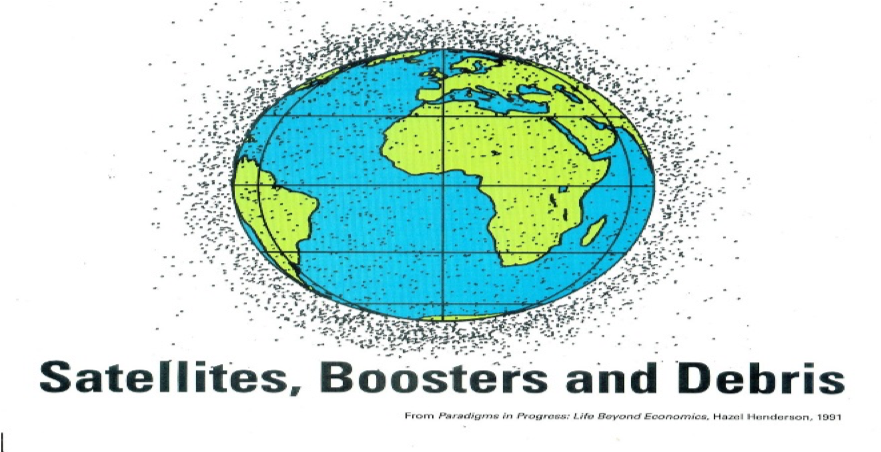Are We Locking Earth Into a Space Prison?

In 1986 Scientific American drew attention to this visual of space junk tracked by NORAD, 7,000 spent rocket debris and the 40,000 objects with a diameter of 10 centimeters or more. I used this visual in many of my presentations in the 1980s and in Paradigms in Progress (1991), making the point that not only was space junk a result of our wasteful, "rearview mirror" industrial paradigm, and that even debris the size of the paint flake which damaged the space shuttle Challenger’s windshield in 1984 could, at orbital speeds endanger future satellites and space travel.
Since then, billions have been contracted to companies offering ways to clean up or corral additional accumulated space junk, with little success. Space has been increasingly militarized and used for satellite-based communications and internet service, with Intelsat’s 59 satellites and those of other countries providing today’s global connectivity.
Recently, the US Federal Communications Commission gave permission to Elon Musk’s SpaceX to set up a vast network, Starlink, of low-orbiting communication satellites, ostensibly to bring the world’s poor 3.5 billion people internet access. Closer examination seems to show that only rich business interests seeking higher-speed communications, including Wall Street’s big banks and high-frequency traders implicated in "flash crashes" will be customers.
Initially, Starlink will consist of 4425 satellites orbiting between 1100 and 1300 kilometers up, so as not to collide with the communications satellites currently in orbit further out into space. Each Starlink satellite will only last a few years, so SpaceX will need to launch new ones every few weeks to replace the dead ones, according to Hugh Lewis who represents the UK Space Agency on the International Space Debris Coordinating Committee. Lewis opines that "Musk is raising money for the Mars program" (The Economist, 10, Nov.2018).
Other companies are competing to launch additional cheap, small, low-orbiting satellites, including Alphabet’s Project Loon, 03B Networks, OneWeb, Amazon’s Blue Rocket, as well as those offering propulsion systems for the launches, including Apollo Fusion with Silicon Valley investors led by Reid Hoffman, which plans to use mercury as a fuel. NASA began moving away from mercury as a fuel in the 1970s due to its toxicity and the US has been tightening rules on the use of mercury for two decades. Bloomberg BusinessWeek reports the danger of using mercury to propel these satellites due to their low altitude (300 to 1200 kilometers above the Earth), quoting Prof. Steve Brooks of the University of Tennessee "It’s a very heavy element that is not going to escape Earth’s gravity. Almost all the mercury you put up there will find its way back down". Prof. Dan Jaffe of the University of Washington adds "Using a toxic chemical that we're spending billions of dollars to clean up is probably a dumb idea" (Nov 20, 2018, p.22).
So how much internet access are the planet’s 3.5 billion poor people going to get out of all this new activity? Very little, it seems, since the markets are those who want higher-speed communications to enhance trading speeds, efficiency and profitability. New revelations about the unanticipated dangers of social media propagandizing "fake news" and sowing hatred, racism, misogyny and political revolts are now well-known. We now know that social media and internet connectivity cannot provide a genuine "public square" for debates while running for profit, using advertising and exploiting their users’ personal data. So why are we risking further proliferation of space junk and dangers of collisions with existing satellites and even eventually closing the window for further space exploration for such dubious, short-term, private profit goals?
The US Office of Technology Assessment (OTA) operated from 1974 until 1996 to assess such long term social and environmental consequences of technological choices. This OTA long term view of many unwise, unsustainable technologies drew fire from special interests and Congress slayed their messenger in 1996. Today, with so many new technologies leaving so many citizens behind and societies experiencing future shocks, like those I describe, over 40 Congress members are calling for re-funding OTA. All it's ground-breaking reports are free downloads at the University of Florida Press Digital Library. "An Assessment of Technology for Local Development" originally published in 1980 and helped launch the "small is beautiful" green Solar Age technologies is also free at www.ethicalmarkets.com
Full disclosure: Hazel Henderson, CEO of Ethical Markets Media, Certified B. Corporation, publishers of the Green Transition Scoreboard® also served on OTA's Technology Assessment Advisory Council from 1974 until 1980.

